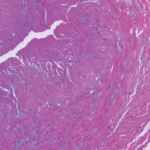Their research continues, with plans to expand their patient database to 1,000 patients and compare logistic regression with a neural network analysis. He says he hopes other investigators will incorporate tests such as ultrasound or dynamic contour tonometry with prediction rule.3
Temporal artery biopsy remains the criterion standard for diagnosis for GCA, Dr. Ing says, but there are some problems with it. “You can have some false negatives, [it’s] time consuming [and] uncomfortable for patients, and surgeons often find it difficult to schedule the biopsy within the two-week glucocorticoid window.”
The model’s GCA calculator is meant to objectify decision making by the patient and doctor. The higher the score, the more likely the patient has GCA and should be treated with glucocorticoids. Patients with a score below 7% may have low risk of GCA and perhaps can be monitored rather than undergoing a biopsy, he explains.
“I was previously unable to provide patients an objective metric for their risk of GCA. The numeric output of the prediction calculator renders objectivity to clinical decision making and allows the physician and patient to better decide what should be done. With risk scores higher than 10–15%, clinicians might be inclined to recommend glucocorticoid treatment and more definitive investigations such as biopsy,” Dr. Ing says.
Possible Study Problems
Note: The authors acknowledged in their paper that it has some limitations and potential weaknesses. In their introduction, they emphasized that the 1990 ACR classification criteria for GCA were not intended for diagnosis. They also said, “Our study had some limitations, which includes its retrospective nature with missing data, the constraint to BPGCA, and misclassification rate.” They also acknowledged that “the limited size of our external validation (EV) sets is a potential weakness.”
According to Peter Grayson, MD, head of the Vasculitis Translational Research Program at the National Institute of Arthritis & Musculoskeletal & Skin Diseases, the investigators should be commended for “going to great lengths to be methodologically rigorous in data analysis and use of statistical methods to account for potential flaws in the dataset, such as missing data.”
The large sample size, internal and external validation techniques, and online risk calculator are good features of the work, says Dr. Grayson. However, some problems with the cohort “cannot be overcome by statistical approaches,” he says. “Notably, a retrospective study design can introduce sources of bias, including selection bias of study subjects and bias due to non-standardized data collection practices across the cohort. A prospective study design in a large independent cohort would be important to validate the findings.”

